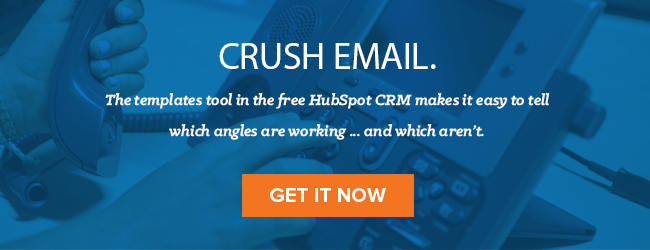I once spent a year as a freelance LinkedIn consultant, which taught me one important thing: Most people have no idea how to leverage their profiles. To this day, the majority of profiles I see contain a few (sometimes many) major mistakes.

If you’re a rep using LinkedIn to generate new leads and engage current customers, having an error-filled profile is especially deadly. In fact, if you’re not getting the results you hope from social selling, your profile may just be the reason why.
So open up a new tab for your LinkedIn -- and check your profile for these nine deadly blunders.
9 Deadly LinkedIn Profile Mistakes
1) Writing Your Profile For Recruiters, Not Prospects
One of the biggest mistakes reps make on LinkedIn is writing for the wrong audience -- recruiters and hiring managers -- rather than prospects and customers.
Most sales professionals use their profile to show off what fantastic sellers they are.
For example:
- Strategically up-sold largest account by 355% (circa $20k/month to $100k/month) in 8 months
- Generated over $650k in total revenue annually, more than 600% growth
- Awarded Varsity Letter for generating over $150k in revenue in one month
But prospects don’t care about the prizes you won and or the profits you drove. They care about one thing: Can you help them?
If your profile doesn’t say “yes,” they’ll find one that does.
2) Leaving Your Summary Blank
If a prospect asked why they should purchase your product, there’s no way you’d stay silent. But leaving your LinkedIn summary blank is, in effect, refusing to answer that exact question.
It’s the perfect place to describe your product’s value prop, establish your credibility with a short customer story, and include a call-to-action with your contact details. Plus, it’s one of the first things every visitor to your profile sees.
In other words, neglecting this section is like setting cash on fire.
3) Overemphasizing Your Previous Positions
When you’re using LinkedIn to network or find a job, adding roughly the same number of bullets to each position you’ve listed makes sense.
But when you’re using LinkedIn to prospect, you want to emphasize your present position -- after all, if you’re, say, currently selling cloud-based IT solutions to startups, your prospects won’t care about your past job selling HR software to corporations.
With that in mind, limit your previous positions to a short description of the position and one or two bullets for your most noteworthy accomplishments.
Here’s an example:
Sales Representative, New York; Yoohoo
I helped small businesses adopt local marketing and advertising strategies, letting them attract and retain new customers as cost-effectively as possible.- On average, my clients saw 74% higher sales in 12 months.
4) Having Your Coworkers Recommend You
Although they might not realize it, prospects often make the decision to buy simply because other people or companies they trust have done so. That’s why every sales rep should leverage social proof -- preferably in the form of client success stories or testimonials.
The “Recommendations” section of your LinkedIn profile happens to be an optimal place to showcase your happy customers. Unfortunately, many reps fill this section with recommendations from their coworkers, who typically make comments like, “Joe can meet a hundred objections but still get the job done,” or “He always finds unique ways to get the prospect’s attention.”
These recommendations remind prospects that you’ve got a vested interest in selling to them.
Recommendations from clients, on the other hand, tell them your product really works -- and contacting you is in their company’s best interest.
5) Using Language Your Prospects Won’t Understand
You’re so well-versed in sales speak it probably doesn’t even sound like jargon anymore. However, most prospects will have no idea what a “President’s Club” is and why qualifying for it is noteworthy, let alone what AM, ARPA, LTV, or SDR stand for.
When someone is mystified by your profile, they don’t pick up the phone to call you -- they move on. That’s why every single section of your LinkedIn should be written in language your prospects will understand.
I recommend asking a couple friends who are unfamiliar with sales to look over your profile for words or terms they don’t know. If they find something you simply can’t cut, add a brief explanation in parentheses, like so:
- Provided infrastructure to ASPs (Application Service Providers)
6) Not Adding Your Company’s Website
Which websites are displayed in the “Contact Info” section of your profile? If you haven’t linked to your company’s homepage, you’re missing a valuable opportunity. These days, buyers do an unprecedented amount of research before contacting a sales rep -- meaning many of the people who browse your profile are probably looking for product information, not your contact details. Make that information hard to find, and they might end up on your competitor’s page instead.
LinkedIn lets you add up to three websites. I recommend using all three slots, like so:
- Company website
- Link to Features or Benefits page
- Link to Testimonials or Use Cases page
Here’s how that would look for a HubSpot Sales rep:

7) Neglecting the Media Feature
LinkedIn lets you add pictures, videos, links, and presentations to your profile. Yet despite this fantastic chance to showcase their company’s marketing materials, I almost never see reps using this feature.
Luckily, it’s easy to fix this mistake. Choose one or two compelling pieces of content (like a third-party article mentioning your product and/or a post from your company blog) then upload them to your summary.

You can also add content to individual positions.

Since you don’t want prospects to spend more than a couple seconds on your old roles, I’d only use this option for the job you have right now.
8) Including Your Personal Beliefs
A few personal details can make you seem more approachable and help create rapport with prospects. However, it’s definitely possible to take this technique too far. After all, if you mention that you hold a certain belief, and a potential buyer happens to hold the exact opposite belief, that’ll inevitably hurt their opinion of you.
And even if your summary is completely free of personal beliefs, you still could be making this mistake. Many reps include their volunteer work for religious or political organizations. While volunteering is always an admirable use of time, this type of affiliation can be risky.
The same holds true for your LinkedIn Groups. Do you belong to any that could be considered controversial? Since your groups shows up at the bottom of your profile, you should consider keeping your membership strictly professional.
Finally, make sure your Interests section is non-objectionable as well.
Not sure whether an interest is safe to include? Ask yourself whether you’d bring it up during small talk with a client. If you’d steer clear, you should definitely leave it off your profile.
9) Using Symbols
Using symbols will definitely make your profile memorable -- but not in a good way. After all, symbols usually show up in text messages and social media posts, so they don’t exactly scream professionalism.

Plus, all those arrows, check marks, and stars make your profile look cluttered and busy. You want people to engage with your profile, not click away as fast as possible.
Once you’ve cleaned up your LinkedIn, your next step is getting people to look at it.
Which mistakes do you see reps making on their LinkedIn profiles? Let us know in the comments!


![17 Best LinkedIn Summary & Bio Examples [+ How to Write Your Own]](https://www.hubspot.com/hubfs/linkedin-summary-examples-4.jpg)
![How to Write a Professional LinkedIn Headline [+ 20 Inspiring Examples]](https://www.hubspot.com/hubfs/how-to-write-an-effective-linkedin-headline-2.jpg)






![How to Write InMail Messages to Recruiters on LinkedIn [Samples + Templates]](https://www.hubspot.com/hubfs/how-to-craft-an-inmail-that-gets-results-1.jpg)